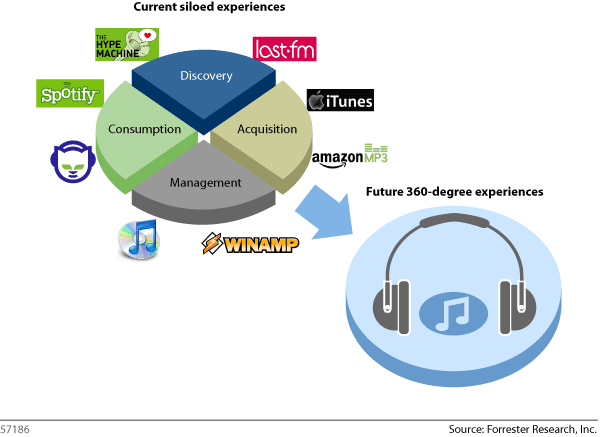360-Degree Music Experiences: Use The Cloud To Target Device-Use Orbits
We have just published a new report that is an essential read for anyone working on a cloud-based music product strategy: 360-Degree Music Experiences: Use The Cloud To Target Device-Use Orbits.
The title of the report is important and highlights the key focus of the report: that cloud-based music services should not be some technology-driven rush to deliver music across as many devices as possible but should instead focus on extending and connecting the digital music experience into what we are calling 360-Degree Music Experiences.
The idea of cloud-based music has been with us for a long time (some of you many remember the decade-old concept of The Celestial Jukebox). Now that technology and connectivity have, to some degree at least, caught up, the cloud is drifting across the digital music marketplace once again. However, numerous hurdles continue to temper the potential:
- Device adoption: most consumers don’t use many devices to listen to music. In fact, most don’t use digital music devices at all. Only a third use MP3 players and 10% music phones.
- Rights issues: should a stream from a cloud copy of an already owned song count as fair use or a licensed stream? Labels think the latter.
- Connectivity issues: 3G speeds outside of urban areas resemble dial-up and Wi-Fi is far from ubiquitous.
- Interoperability issues: rights managed cloud services will only work on supported devices. But even ‘open’ offerings will only work on supported devices — e.g. Spotify won’t work on BlackBerrys.
Even if the final three bullets were fixed tomorrow, the inescapable fact is that few consumers currently use a wide number of devices to listen to music. For example, just 5% listen via MP3 player, and phone, and PC and home streaming. In the report, we present systematic analysis of every combination of music device usage: we call them Music Usage Orbit Clusters. One of these clusters towers over all others: the PC/MP3 player orbit.
The challenge for any music service or music device manufacturer is how to help digital music break free of the chains of the PC and the MP3 player. Getting music into the living room has to be a key priority (the iPod docking station is a Band-Aid, and the TV set-top box reinforces the supremacy of TV content over music).
The overriding objective though for cloud-based music services is to join the dots of the digital music experience (see graphic below). The impact of legacy rights and technology factors have resulted in a fragmented digital music experience in which the consumer has to jump across multiple services and platforms to get the best-of-breed experience. The true potential of music services that leverage the cloud is not ubiquitous device access but joining the dots of the digital music experience so that discovery, acquisition, management and consumption can all happen within one unified 360-degree music experience environment.
